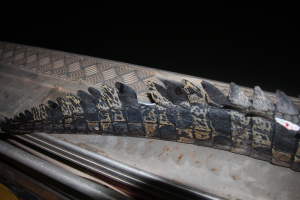Large crocodiles in the Alligator Rivers region of north Australia do much of their dining not within their rivers or estuaries, but on feral pigs and other terrestrial animals visiting the waterways, a new study has revealed.
The work, published in PLOS ONE, forms part of a larger study of river and floodplain food-webs led by Griffith University’s Australian Rivers Institute in collaboration with Parks Australia and other partners of the Northern Australian Environmental Resources Hub.
“Our work aims to identify the important sources of food that sustain populations of fish and other large animals in these river systems, and in particular to understand how dependent they are on the seasonal connection with the floodplain,” Director of the Australian Rivers Institute Professor Stuart Bunn said.
Crocodiles are considered to be the apex aquatic predator in these systems.

Taking ‘scute’ samples helped researchers determine what the crocodiles were eating.
“We know from many years of studying them in Kakadu, that they eat a broad variety of freshwater and marine animals,” Gary Lindner from Parks Australia said.
“However, there are plenty of feral pigs for the taking, and it seems that many larger crocodiles also take advantage of that.”
About 50 estuarine crocodiles were tested over a two-year period for the study and 75% of those tested were considered large (more than 2.5m).
Although direct observation of crocodile feeding habits and their stomach contents confirms they eat a wide range of prey, not all contributes equally to their body growth.
“We used chemical tracers in their muscle tissue to distinguish between the different major prey groups from terrestrial, freshwater and marine environments, including mullet, barramundi, catfish, wallabies, and cattle,” Dr Fernanda Adame from Griffith University said.
“Predators take on the combined signature of their prey — and you literally ‘become what you eat’ and end up having the same chemical signature as their prey, In this study, most of the large crocodiles had a distinctive terrestrial prey signature, and were most similar to that of feral pigs.”
In many parts of the world, large rivers have become disconnected from their floodplains because of changes to flow regimes or levees and other barriers, with major consequences to biodiversity and productive fisheries.
Northern Australia’s rivers are largely free-flowing and connected to their floodplains and estuaries, and this underpins their outstanding natural and cultural values.
“This study highlights the important interconnections between rivers and their floodplains,”
Professor Bunn said.
